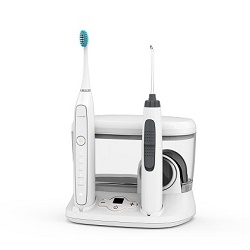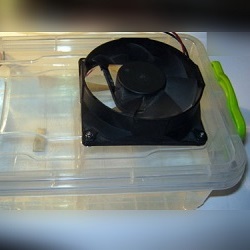How does the electric water activator
The electroactivator of water changes its structure at the molecular level and saturates monomolecules by simple electrolysis. As a result, the user receives "live" and "dead" water, which is increasingly used for medicinal purposes. According to biophysical and biological indicators, such water is considered more active, its natural properties are enhanced. Let us consider in more detail the work of such an activator and the benefit of the water obtained.

Content
Device design and activation method
The electric activator is a simple electrical device for restructuring or activating ordinary water. In one cycle, the device simultaneously activates water or an aqueous solution of two types: catholyte (live, alkaline) and anolyte (acid, dead). Each device consists of several elements:
- basic bowl for alkaline water conversion;
- removable container or glass made of cloth, ceramics;
- power supply from the network;
- top cover of the device.
A large bowl of an electric activator is made from safe food plastic, it is in it that, by electrolysis, ordinary water is structured into “living”. The removable container made of ceramic or fabric serves as a diaphragm (partition) between the catholyte and the anolyte, while the acidic “dead” water is structured in it.
Bottom in the cover of the activator is placed four electrodes: a pair of anodes with a sheath with a chemically resistant coating and a pair of cathodes made from food or stainless steel.
The electrodes of the activator, designed and manufactured in an industrial environment, are not destroyed by the action of electrochemical processes, which is different from home-made devices.
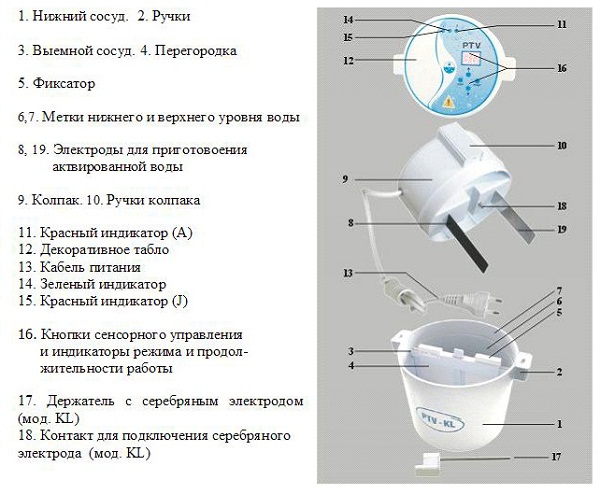
During each conversion cycle, the electric current enters the water through the electrodes, changes its catalytic and reactive activity. Also, electrolysis changes the entire chain of intermolecular interactions, and, as a result, affects the structure of water or aqueous solution at the physical level.In other words, under the action of an electric current in tap, distilled or filtered water molecular structure changes.
The cathodic electrochemical effect on the liquid turns part of the salts into hydroxides, giving the water alkaline properties. The concentration of hydrogen increases, while nitrogen and oxygen, on the contrary, decreases. Due to the manifestation of stable and unstable acids (sulfuric, persulfur, hydrochloric), anodic treatment intensively increases the acidity in aqueous solution, significantly increasing the redox potential ,.
Use of the device
The use of household electroactivator for tap or distilled water does not cause any difficulties. The action algorithm is simple:
- in a flask of ceramic (or tarpaulin) pour water to the top level;
- water is poured into a plastic bowl 1.5 cm below the edge of the ceramic diaphragm;
- connect the activator to the mains.
The process of structuring lasts from 10 to 40 minutes: the longer the device operates, the higher the concentration of trace elements. After 40 minutes the electrolysis stops and the device should be turned off.Between cycles it is recommended to make small pauses from 5 to 20 minutes.
To avoid overheating during activation it is important to control the temperature of the plastic bowl and power supply. The current supply increases when the mineralization of the water is too high. For the same reason, it is impossible to pour saline solution for the formation of catholyte and anolyte in one cycle.
After the activation is completed, the water is settled for about an hour; white scurf or sediment throughout the inner area. Its use is prohibited, later the sediment must be drained into the sewer. A white bloom collects on the walls of the ceramic cup, and the user manual indicates the frequency of cleaning the anolyte container. Usually, before every tenth cycle the glass is placed in vinegar. Stainless steel or food steel electrodes are wiped with any household rag, and black ones clean themselves, it is unacceptable to clean them mechanically or with special means.
Catholyte and anolyte, belonging to the class of metastable elements, over time, they lose their unique properties. The effect of activated water lasts for 7 hours after treatment. Storage of water or saline in the refrigerator does not make sense, the liquid should be consumed immediately.
"Living" and "dead" water
The purpose of the operation of each activator is the restructuring of water, and any electrical device contains two tanks, in one process the device makes both “dead” and “living” water. For example, the gaining popularity of the AP-1 looks like a regular filter jug, inside which there is a small additional capacity.
The definitions of "living" and "dead" water are arbitrary, in both cases it is ordinary water with an altered molecular structure. The term “living water” means catholyte, which stimulates all biological processes, and “dead” - anolyte, means deceleration.
There are many different opinions about the miraculous properties of healing water. One can argue for a long time whether it is a myth or a reality, but one cannot deny the physical processes that occur at the molecular level.
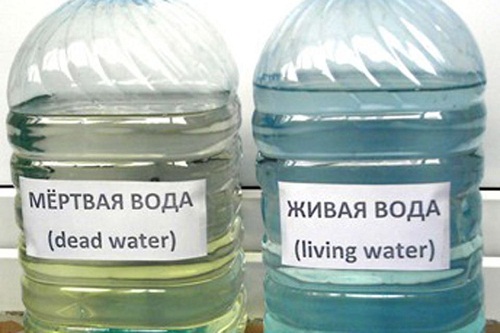
The benefits of "living" water
Living water or catholyte possesses alkaline properties, has a high ph value - about 10 units. Under the influence of electric current, a part of the molecules decomposes into hydrogen ions.Alkaline water promotes life and has a strong bio-stimulating effect. Therefore, it is used to cleanse the body, heal wounds, and seeds treated with "living" water, bloom and germinate more quickly.
Naturally, such water cannot be called a panacea for all diseases and is hardly allowed to be taken as an independent medicine. At the same time, its benefits to the body are difficult to diminish:
- water enriched with alkali promotes the healing of all wounds, burns;
- helps to cure ulcers;
- cleans the body, removes toxins faster;
- increases blood pressure and strengthens the immune system;
- It has a beneficial, healing effect on the kidneys, liver, and the entire digestive system;
- enhances the impact of medication.

Dead water features
Dead water or anolyte is endowed with slowing properties and suspends any biological processes. It is used for disinfection:
- cleansing vegetables or fruits, which increases their shelf life;
- disinfection of any items;
- in alternative medicine for the destruction of allergens, fungi and other bacteria.
Anolyte is an acidic water with a low ph level (3-4 units), when interacting with bacteria, it destroys cell walls, blocks protein synthesis. In simple terms - “dead” water freezes the vital activity of microorganisms, which is useful for humans in the fight against various diseases.
Overview of modern water electroactivators
Below we give the most popular examples of industrial activators. Despite the widespread prevalence, not all of the models presented do a good job.
AP-1 device
The electric activator for AP-1 water - one of the most popular. The device is different good quality production:
- the main container is made of high-grade plastic;
- heavy-duty electrodes made of titanium, platinum and stainless steel;
- the ceramic diaphragm is made from a special grade of clay.
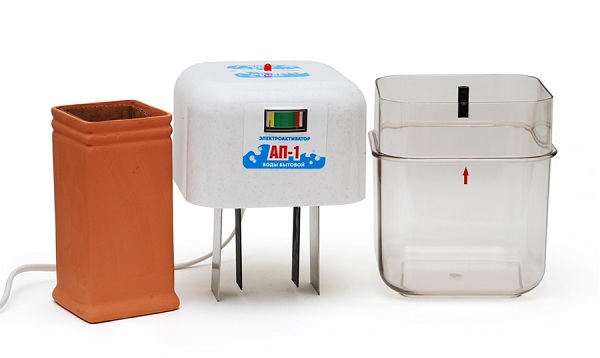
An activator with a power of 70 W consumes no more than 40 W during operation, which makes it quite economical. In one cycle of 20–30 minutes, the AP-1 is able to activate almost one and a half liters of structured water. The device AP-1 does not differ in stylish and modern design, but will easily and imperceptibly fit into any kitchen.
The cost of the AP-1 is slightly higher than similar devices, thanks to the built-in indicator of water quality.
"Zdravnik"
The simple device is issued in two versions: with a ceramic or tarpaulin glass. The second one is a bit cheaper. "Zdravnik", manned ceramic cup, at a price approaching the AP-1, but significantly inferior to him in quality and functionality.
The design is very similar to AP-1:
- plastic container;
- a glass of ceramic or tarpaulin;
- stainless steel electrodes.
"Melesta"
Its advantage is the price, otherwise the device attracts little attention. Naturally, Melesta will cope with its main task, but it has some drawbacks. For example, the design implies only fabric glasswhich is inferior to ceramics. Instead of four electrodes, there are only two made of food steel. External device data will not earn more than three points: a rough performance and mediocre design.
Naturally, the deficiencies do not affect the quality of the water, the result of activation will be similar to AP-1 or professional PTV. But the term of work, ergonomics and aesthetics are still flawed.
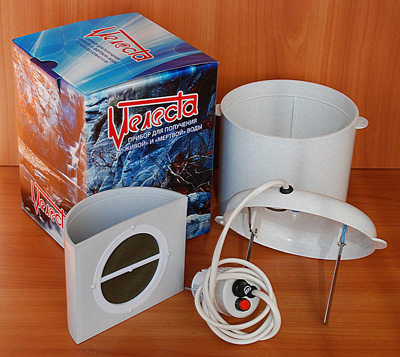
PTV
PTV is designed to professional use in sanatoriums or dispensaries, but it is often purchased for the home. The advantage of the activator for water in its resource, here the manufacturer has installed thick electrodes, which significantly increases its service life. The power of the device is only 75 watts.
PTV also differs in its design: instead of a ceramic glass for anolyte in the device, there is one container divided by a wood membrane. The only disadvantage of the activator in its cost, but the best quality requires.

/rating_on.png)
/rating_half.png)
/rating_off.png)







